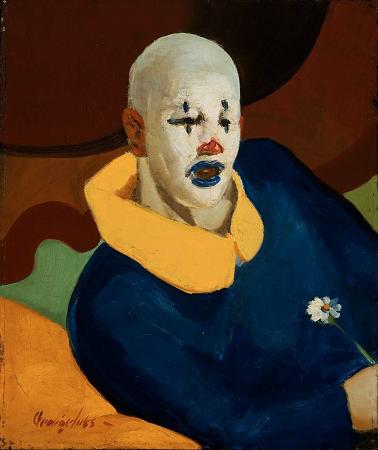Genre with Clown. A clown is a person who performs physical comedy and arts in an open-ended fashion, typically while wearing distinct makeup or costuming and reversing folkway-norms. Clowns are often depicted in art as figures of comedy and joy, bringing laughter and happiness to others. Clowns can also be portrayed as figures of sadness and tragedy. This is particularly evident in the work of artists like Pablo Picasso, who depicted clowns as lonely and isolated figures. Clowns can also be portrayed as ambiguous and paradoxical figures, embodying both joy and sorrow, humor and pathos. The art of performing as a clown is known as clowning or buffoonery, and the term clown may be used synonymously with predecessors like jester, joker, buffoon, fool, or harlequin. Clowns have a diverse tradition with significant variations in costume and performance. The most recognisable clowns are those that commonly perform in the circus, characterized by colorful wigs, red noses, and oversized shoes. However, clowns have also played roles in theater and folklore, like the court jesters of the Middle Ages and the jesters and ritual clowns of various indigenous cultures. Their performances can elicit a range of emotions, from humor and laughter to fear and discomfort, reflecting complex societal and psychological dimensions. Through the centuries, clowns have continued to play significant roles in society, evolving alongside changing cultural norms and artistic expressions. The most ancient clowns have been found in the Fifth Dynasty of Egypt, around 2400 BC. Unlike court jesters, clowns have traditionally served a socio-religious and psychological role, and traditionally the roles of priest and clown have been held by the same persons.Peter Berger writes, It seems plausible that folly and fools, like religion and magic, meet some deeply rooted needs in human society. For this reason, clowning is often considered an important part of training as a physical performance discipline, partly because tricky subject matter can be dealt with, but also because it requires a high level of risk and play in the performer. In anthropology, the term clown has been extended to comparable jester or fool characters in non-Western cultures. A society in which such clowns have an important position are termed clown societies, and a clown character involved in a religious or ritual capacity is known as a ritual clown. Many native tribes have a history of clowning, such as the Pueblo clown of the Kachina culture.
more...







